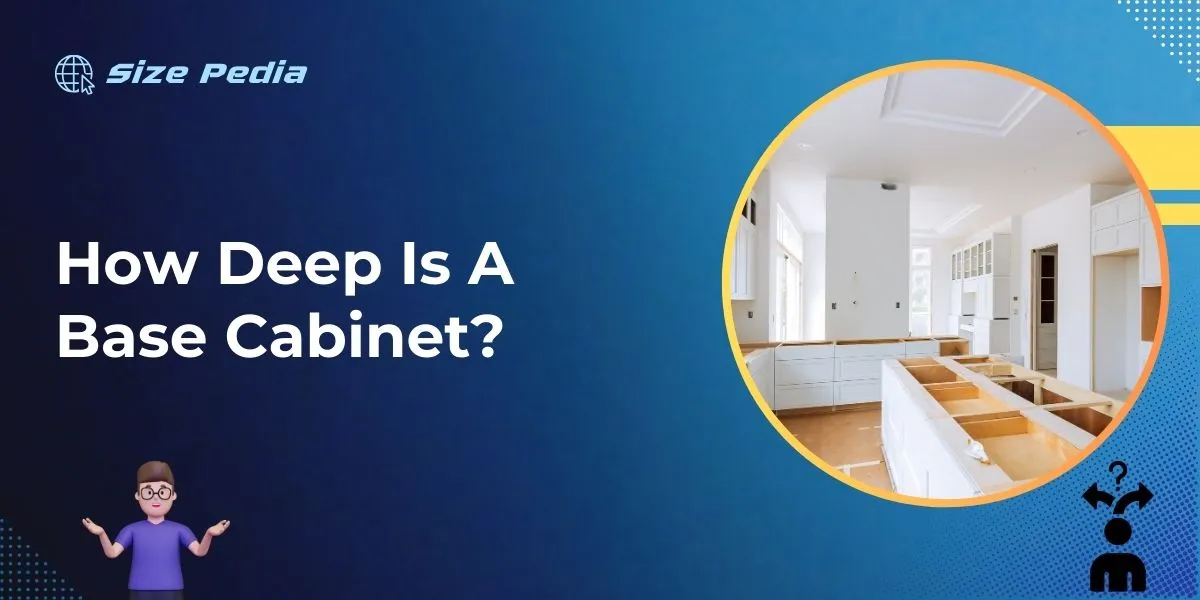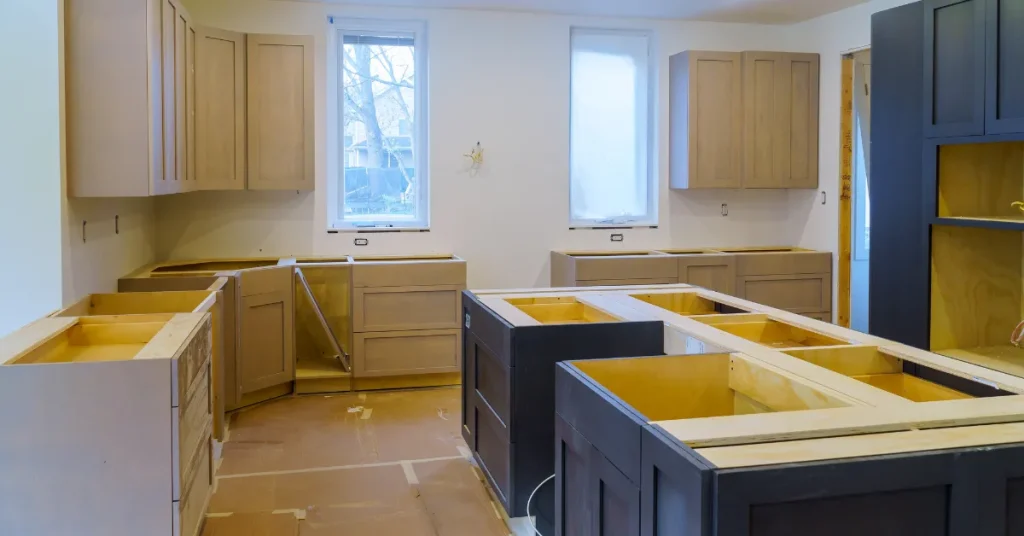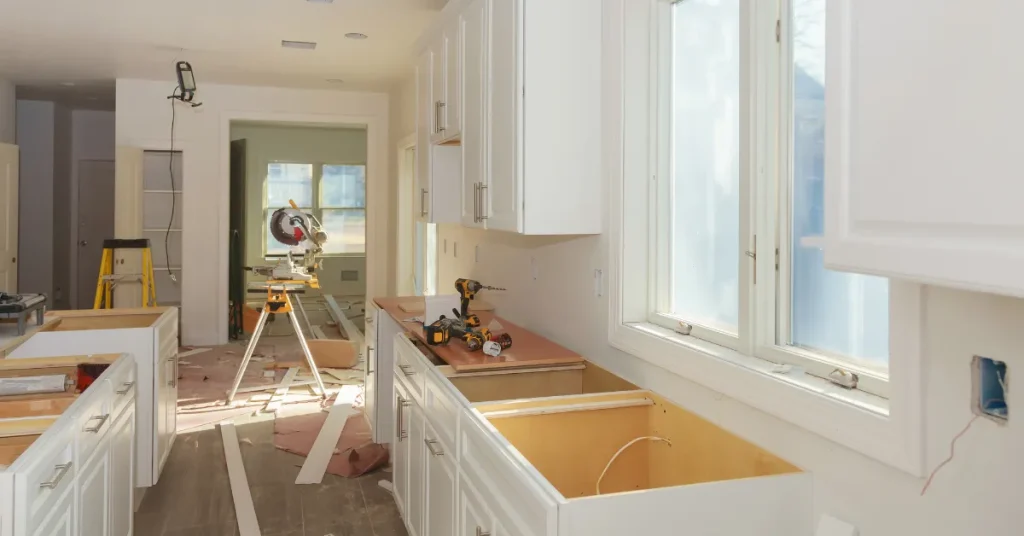A standard base cabinet is 24 inches deep. Depth can vary from 12 to 24 inches for custom designs.
Base cabinets are fundamental components in kitchen and bathroom design, providing storage and space for plumbing connections under sinks. They typically stand 34. 5 inches tall, without countertops, and have a depth that ensures ample workspace on the counters above.
The depth of 24 inches is specifically chosen to balance accessibility with maximizing available space. Proper installation of these cabinets not only optimizes your storage potential but also contributes to the overall functionality and aesthetics of the room.
Choosing the right depth for your base cabinets can have a significant impact on kitchen ergonomics and user satisfaction.

The Standard Depth Of Base Cabinets
In the quest to create the perfect kitchen, understanding the standard depth of base cabinets is crucial. These cabinets are the workhorses of kitchen storage.
They not only support countertops but also house everything from pots and pans to mixers and groceries. The depth of these cabinets can affect your kitchen’s functionality and overall feel.
Typical Dimensions
When discussing base cabinets, their typical dimensions are vital for proper kitchen planning. While sizes can vary, there are common measurements most manufacturers adhere to.
| Component | Typical Depth |
| Base Cabinet (without countertop) | 24 inches |
| Base Cabinet (with countertop) | 25 to 26 inches |
| Toe Kick | 3 to 4 inches |
These are general guidelines that most homes follow. Yet, personal preferences and specific design needs can adjust these numbers.
Factors Affecting Depth
- Appliance Size: Large appliances might need deeper cabinets.
- Space Constraints: Smaller kitchens may require shallower units.
- Accessibility: Needs for reach and usability can influence depth choices.
- Customization: Personal style can lead to tailored cabinet depths.
When designing or renovating a kitchen, remember to consider these factors. They will ensure your cabinets meet your everyday needs. Consult professionals if in doubt, ensuring your space is both beautiful and functional.
Measuring Base Cabinet Depths

Knowing the exact depth of your base cabinet is essential. It ensures that your storage fits your space perfectly. Let’s dive into the process of measuring your base cabinet’s depth correctly.
Tools Required
You’ll need a few tools before you get started:
- Tape measure: to find the cabinet depth.
- Notebook and pencil: for recording measurements.
- Level: to make sure surfaces are even.
Step-by-step Process
- Empty your cabinet: Remove items for accurate measurement.
- Measure internal depth: Place tape measure at the back of the cabinet, then extend it to the front edge.
- Record the measurement: Write down the number on your notebook.
- Check for square: Use the level to confirm your cabinet’s corners are 90 degrees.
- Measure external depth: Include the thickness of doors and the front edge if necessary.
- Double-check: Measure twice to avoid any mistakes.
Now you know the exact depth of your base cabinet. Use this information to plan your kitchen layout or purchase accessories that fit just right.
Variations In Base Cabinet Sizes
Think kitchen cabinets are one-size-fits-all? Think again! Base cabinets, the workhorse of kitchen design, come in a variety of sizes. These sizes can affect both storage space and the overall look of a kitchen.
Standard base cabinets typically have a depth of 24 inches and a height of 34.5 inches. But things can get more exciting when you dive into the world of custom designs and brand-specific dimensions.
Custom Designs
Want cabinets that fit like a glove? Custom base cabinets are the answer. They match unique kitchen layouts and personal styles.
- Depth: Can range from 12 to 27 inches to best utilize space.
- Height: Customized to accommodate different counters or appliances.
- Width: Often between 9 and 48 inches, tailored to specific needs.
A custom approach ensures no space goes to waste. Homeowners can maximize every inch with custom base cabinets.
Brand-specific Dimensions
Each cabinet brand might offer slightly different sizes. These variations can make a big difference in your kitchen’s functionality.
| Brand | Standard Depth (in.) | Standard Height (in.) | Common Widths (in.) |
| Brand A | 24 | 34.5 | 12, 15, 18, 24, 30, 36, 42, 48 |
| Brand B | 24 | 34.5 | 15, 20, 25, 30, 35, 40, 45 |
Before buying, measure your space. Consider brands that offer sizes reflecting your needs.
Maximizing Kitchen Space

Kitchens need space for cooking, eating, and storing. A deep base cabinet can help a lot. It saves space and keeps kitchens neat. Let’s see how to make kitchens better with the right cabinet depth.
Optimal Depth For Efficiency
The ideal depth for base cabinets is 24 inches. This size fits most kitchen items. Deep enough for pots and pans, but reachable too. Shallow cabinets waste space. Too deep, and reaching for items gets hard. Remember, a good fit means easy cooking.
- Regular items: Within arm’s reach
- Bulky appliances: Easy to pull out
- Deep corners: Use for seasonal items
Design Tips
Smart design turns small kitchens into great ones. Here’s how:
- Use drawers for better reach.
- Add organizers. They keep things tidy.
- Pull-out shelves save your back.
- Corner cabinets: Carousel shelves help a lot.
Measure your space before choosing cabinets. This keeps your kitchen user-friendly. A well-planned kitchen is a happy kitchen. Use every inch wisely!
Impact Of Depth On Storage
The depth of a base cabinet is crucial to its function. Not only does it determine how much you can store, but it affects ease of reaching items as well. Let’s delve into the ways cabinet depth impacts storage.
Storage Capacity And Accessibility
A deeper cabinet means more volume for storing pots, pans, and kitchen gadgets. However, an extremely deep unit might make it harder to find and retrieve items. A standard base cabinet typically measures 24 inches deep.
But don’t think that deeper is always better. Let’s explore the benefits and possible setbacks of base cabinet depth.
- Standard Depth: At 24 inches, you have ample space without stretching to reach the back.
- Greater Depth: More than 24 inches—it can store bulky appliances, but items may get lost in the shuffle.
- Shallower Depth: Less than 24 inches, suitable for tight spaces and keeps everything within easy reach.
Organizing Tips
Effective organization enhances storage capacity and accessibility, irrespective of depth. Here are some tips:
- Use drawer dividers for easy item segmentation.
- Install pull-out shelves to bring items in the back within reach.
- Add spice racks to cabinet doors to free up shelf space.
Remember, smart organization turns a seemingly small space into a storage powerhouse. Make the most of your cabinet depth with creative solutions!
FAQs About How Deep Is A Base Cabinet
What Is The Standard Depth Of Base Cabinets?
Standard base cabinets typically have a depth of 24 inches. This measurement does not include the countertop overhang. Some variations may occur due to customization or specific design requirements.
Can Base Cabinet Depth Be Customized?
Yes, base cabinet depth can be customized to suit individual needs and kitchen layouts. While 24 inches is standard, depths can range to suit special circumstances or preferences.
Does Base Cabinet Depth Include Doors?
The standard measurement of 24 inches for base cabinet depth usually does not include the doors. Doors add about 1 inch, making the total depth with doors approximately 25 inches.
What’s The Minimum Base Cabinet Depth For Kitchens?
The minimum depth for base cabinets in a kitchen is typically 12 inches. These are used for specific areas where space is limited or for storing smaller items.
Conclusion
Understanding the typical dimensions of base cabinets is critical for efficient kitchen design. With most standing at around 24 inches deep, planning your space becomes a breeze.
Remember, customization options can alter these measurements to fit unique layouts. Ready to optimize your kitchen’s functionality?
Measure twice and design once for the best results.
Resources:
1. https://www.hud.gov/sites/dfiles/FHEO/documents/The-Fair-Housing-Act-Requirement-7-Kitchens-Participant-Workbook.pdf
